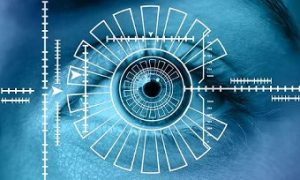
Highly accurate biometric technology, once found exclusively in military and other secretive government facilities, is going mainstream. You’ll now find iris recognition readers protecting office buildings and college campuses — even being used for time and attendance in factories. As costs have dropped, iris biometrics now are being considered by high-end homeowners. In fact, the iris recognition market is projected to expand from $676.6 million in 2016 to $4.1 billion by 2025.
Here are four reasons security pros should add iris recognition readers to their product lists.
1. Biometrics Are Cool
Imagine the pride your customer will have taking his friends into his wine cellar — accessed only via an iris reader. Think of the peace of mind that comes with knowing children can’t find a key or a PIN to access a gun room. The female head of the household can protect her dressing area storing fine jewelry and designer apparel. And a safe room can allow access only to family members.
The areas protected by an iris reader are limited only by imagination. There’s no need to keep a cabinet of keys, each capable of being lost, stolen or copied. PINs can be forgotten or figured out by others in the home. And like keys, access cards can be misplaced.
Iris readers are a fun amenity when it comes time to sell the home. And being non-contact, unlike keypads and fingerprint readers, iris readers are very hygienic.
2. Iris Readers are Super Secure
Iris recognition identifies the patterns of the iris, the colored part of the human eye surrounding the pupil. Every iris pattern is unique and stable for life. Since there are more readily measurable characteristics in the iris, the technology has become the most accurate, fastest and scalable option for biometric use. Other biometric technologies such as fingerprint, hand, voice, vein and facial recognition can often vary and change over time or with use conditions. The enrollment process involves a reader taking a non-contact digital picture of the iris pattern and creating a small encrypted, algorithmic digital template with more than 240 unique characteristics. The resulting 512-byte templates cannot be re-engineered or reconstituted to produce any sort of visual image. A picture of a person’s iris won’t gain access to a protected door.
3. Iris Scan Recognition Is Affordable
Admittedly, iris recognition systems aren’t yet priced for the mass market. But for a customer already spending tens of thousands of dollars on a home entertainment center, the added security of a biometric system is worth the investment. For multi-tenant properties, the premium over traditional credentialing systems would be nominal. Readers typically sell for between $1,000- $2,000 and typically last for years.
4. Installer- and User-Friendly
Installation of an iris reader is similar to other devices connected to electronic locks — wiring options are dependent on the hardware being used. Wall mounting a reader is simple. If used outdoors — at a front door or gate — the reader may require a housing to prevent direct sunlight from reaching the lens and interfering with authentication. In areas where the temperature may drop below 32 degrees or top 113 degrees Fahrenheit, a heating/cooling housing similar to what’s used for a security camera may be needed. When used indoors, the readers require no special housings or shade.
As with other credentialing systems, iris readers can be standalone or part of a larger networked systems. An embedded holographic targeting mirror is used for both enrollment and authentication — with the user positioned about 14 inches away — and the guest need not remove glasses or contact lenses. As with other access-control solutions, iris scanners can store a number of images associated with specific permissions granted by the owner. Because of their hygienic properties and almost-undefeatable security, iris recognition systems are routinely used in military and other government facilities, as well as corporate data centers, national ID programs, voter registration and border crossings.











